Cyclists Hub is supported by its readers. We may receive a commission if you buy products using our links.All content on Cyclists Hub is written by humans, not robots. Learn More
This is my selection of the best power meter pedals for road, mountain, and gravel bikes available on the market. I selected them based on my experience, discussions with pro-cyclist friends, reading hundreds of customer reviews, and accuracy tests.
- The best power meter pedals for a road bike are the Favero Assioma RS, as the lightest pedal power meters on the market. They provide excellent consistency and accuracy of ±1%. They are also more affordable than the closest alternatives.
- The best power meter pedals for mountain and gravel bikes are Favero Assioma Pro MX1 (single-sided) or MX-2 (dual-sided). They offer the same reliability and price-value ratio as the Assioma for road cycling and are much more affordable than the competition.
You will learn more about them below.
If you are new to power meter pedals and don’t know what to look for, don’t worry. I will guide you through the options available on the market.
Let’s dive in.
What Are the Best Power Meter Pedals?
The best pedal power meters have an accuracy rate of around ±1%, provide consistent and reliable data, are durable enough to withstand frequent use, and are lightweight. This means the road bike pedals weigh around 300g and the MTB around 450g.
You can skip to the buyer’s guide section to learn more about power meter pedals and their features.
Favero Assioma RS (Best Road Bike Power Meter Pedals)
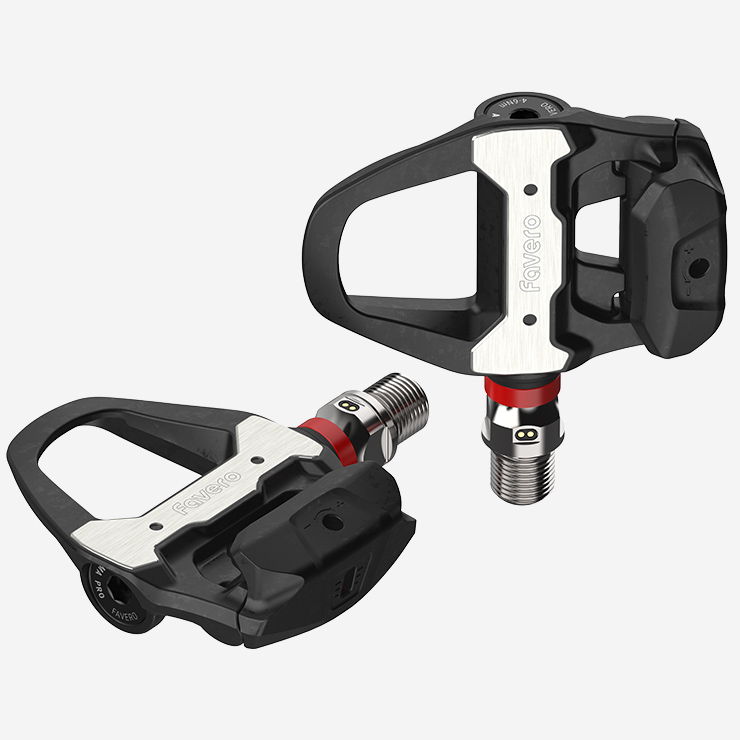
Favero Assioma RS-1 scoring:
Accuracy 5/5 | Reliability 5/5 | Ease of Installation 5/5 | Battery Life 2/5 | Price 4/5 | WEIGHTED OVERALL SCORE 4.5/5
Favero Assioma RS-2 scoring:
Accuracy 5/5 | Reliability 5/5 | Ease of Installation 5/5 | Battery Life 2/5 | Price 2/5 | WEIGHTED OVERALL SCORE 4.3/5
Main Features
- The lightest pedal power meter for Shimano SPD-SL cleat standard
- Highly accurate and consistent
- Advanced features (L/R balance, pedal smoothness, etc.)
- Automatic zero-offset
- 2-year warranty
Technical Specification
- Accuracy: ±1%
- Weight: 250g (set)
- Cleat system: Shimano SPD-SL
- Claimed battery life: 60h
- Battery type: Rechargeable
- Spindle length: 53 mm
- Stack height: 10.5 mm
After the success of the Favero Assioma UNO and DUO series, it was only a matter of time before we saw a dedicated version for the Shimano SPD-SL cleat standard. It’s finally here, and the Assioma RS pedals have immediately become one of the top pedal power meters for road bikes. In addition to their reliability and accuracy, they are particularly impressive for their very low weight, which is similar to that of Shimano Ultegra pedals. These are the lightest pedals with a power meter for road bikes.
Compared to the UNO and DUO series, they also have 10 hours longer battery life and a redesigned look. Now, the electronics are fully concealed in the axle. Of course, both single-sided and double-sided versions are available. As expected, the price has increased, but not by much, so the RS-2 is still a better deal than the Garmin Rally.
Favero Assioma UNO and DUO (Best Budget)

Favero Assioma UNO scoring:
Accuracy 5/5 | Reliability 5/5 | Ease of Installation 5/5 | Battery Life 2/5 | Price 4/5 | WEIGHTED OVERALL SCORE 4.5/5
Favero Assioma DUO scoring:
Accuracy 5/5 | Reliability 5/5 | Ease of Installation 5/5 | Battery Life 2/5 | Price 3/5 | WEIGHTED OVERALL SCORE 4.4/5
Main Features
- Most popular pedal power meters
- Highly accurate and consistent
- Advanced features (L/R balance, pedal smoothness, etc.)
- Automatic zero-offset
- 2-year warranty
Technical Specification
- Accuracy: ±1%
- Weight: 299g (set)
- Cleat system: Look KEO (or Shimano SPD-SL with DUO-Shi spindles)
- Claimed battery life: 50h
- Battery type: Rechargeable
- Spindle length: 54 mm
- Stack height: 10.5 mm
Favero Assioma are still one of the most popular pedal power meters on the market (I think this will change with the RS-series). This is because they are highly accurate, reliable, and, more importantly, affordable.
Depending on your budget and needs, you can choose a single-sided (UNO) or dual-sided (DUO) option. I recommend UNO for beginners and people on a tight budget, and DUO for advanced riders who can take advantage of the additional data.
Assioma DUO power meter pedals can independently measure your left/right leg balance, pedal smoothness, time seated vs. standing, etc.
Unlike the previous generation of Assioma pedals, the latest one has an auto-zero feature (what is it?). So you don’t have to think about performing it before every ride.
The Favero Assioma(s) has a much shorter battery life (up to 50 hours) than other road power meter pedals like Garmin Rally RS. Luckily, the battery is rechargeable, so you don’t have to replace it like you did with the first-generation Rally.
Remember, Favero Assioma UNO and DUO pedals are designed for the Look KEO cleat system. You can use Favero Assioma DUO-Shi spindles that will allow you to transform your Shimano SPD-SL pedals into a power meter. However, I don’t think it makes much sense now when there is the RS-series, which is compatible with the SPD-SL cleats standard.
You might also be interested in this in-depth comparison between Favero Assioma and Garmin Rally.
Favero Assioma PRO MX (Best SPD Power Meter Pedals for MTB and Gravel Bikes)
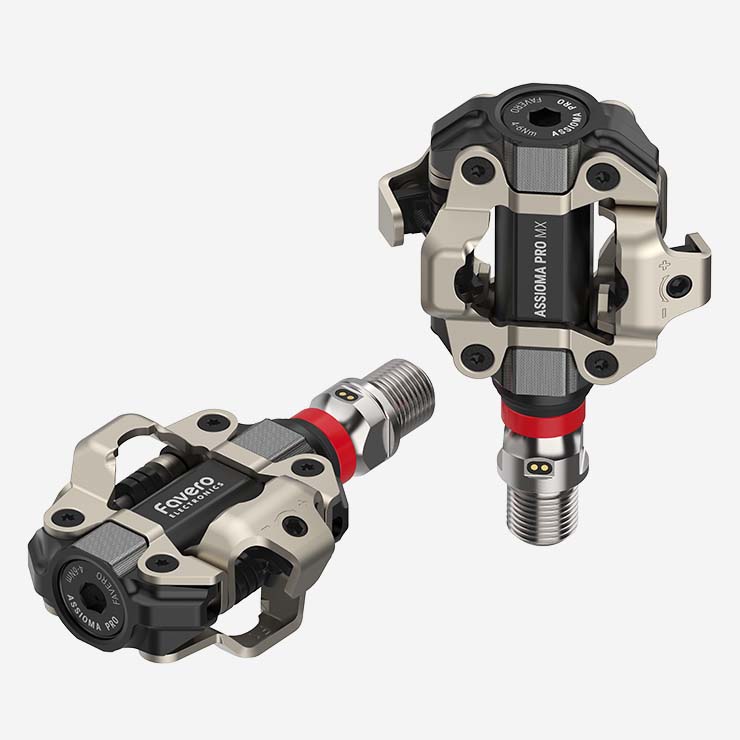
Favero Assioma PRO MX-1 scoring:
Accuracy 5/5 | Reliability 5/5 | Ease of Installation 5/5 | Battery Life 2/5 | Price 4/5 | WEIGHTED OVERALL SCORE 4.5/5
Favero Assioma PRO MX-2 scoring:
Accuracy 5/5 | Reliability 5/5 | Ease of Installation 5/5 | Battery Life 2/5 | Price 3/5 | WEIGHTED OVERALL SCORE 4.4/5
Main Features
- Highly durable
- Advanced features (L/R balance, pedal smoothness, etc.)
- Available in single-sided or dual-sided options
- Automatic zero-offset
- 2-year warranty
Technical Specification
- Accuracy: ±1%
- Weight: 383g (set)
- Cleat system: Shimano SPD
- Claimed battery life: 60h
- Battery type: Rechargeable
- Spindle length: 53 mm
- Stack height: 11.2 mm
The Assioma PRO MX is Favero’s first MTB pedal power meter. It was officially introduced in early 2024, and from initial reviews, it seems that it will be as reliable as the Assioma UNO/DUO.
Unlike the Garmin Rally XC, they have a rechargeable battery and automatic zero-offset, but shorter battery life. They are cheaper and about 60g/pair lighter.
In my opinion, there’s no reason to pay a premium on a Garmin XC unless you’re in their ecosystem. The PRO MX pedals offer much better value for money.
Also available at cycling.favero.com
Also available at cycling.favero.com
Garmin Rally XC110 and XC210

Garmin Rally XC110 scoring:
Accuracy 5/5 | Reliability 5/5 | Ease of Installation 5/5 | Battery Life 2/5 | Price 2/5 | WEIGHTED OVERALL SCORE 4.3/5
Garmin Rally XC210 scoring:
Accuracy 5/5 | Reliability 5/5 | Ease of Installation 5/5 | Battery Life 2/5 | Price 1/5 | WEIGHTED OVERALL SCORE 4.2/5
Main Features
- Highly durable
- Advanced features (L/R balance, pedal smoothness, etc.)
- The spindle is compatible with multiple conversion kits
- Available in single-sided or dual-sided options
- 2-year warranty
Technical Specification
- Accuracy: ±1%
- Weight: ~450g (set)
- Cleat system: Shimano SPD
- Claimed battery life: 90h
- Battery type: Rechargeable
- Spindle length: 53 mm
- Stack height: 11.5 mm
For a long time, Rally XCs didn’t have many alternatives. This changed in 2024 with the introduction of Favero Assioma Pro MX and LOOK X-Track power.
Pedal power meters are also more prone to damage, so consider a spider or a crank power meter for your MTB instead (check out the best ones here).
In 2021, Garmin introduced a series of new power meter pedals, including the XC100 (single-sided) and XC200 (dual-sided), and revamped them in 2025 with the XC110 and XC220. They now have a rechargeable battery and a few minor improvements.
The single-sided option is ideal for beginners on a tight budget. On the other hand, data geeks and demanding riders will appreciate the dual-sided option.
Both pedals are compatible with the Shimano SPD cleats system, which is the most popular among cross-country riders and is also often used on gravel bikes.
One of the biggest advantages of Rally is spindle transferability. You can use conversion kits to use this power meter on your road bike with SPD-SL cleats (Garmin Rally RS) or LOOK KEO (Garmin Rally RK), for example. This way, you save money on power meters and get consistent data across multiple bikes.
Rally XC pedals are also durable enough to withstand elements like water, mud, dirt, etc. They also handle accidental rock impacts, but don’t forget they still include sensitive electronics. So, super-harsh conditions are not recommended.
One of the most significant downsides of the Rally line is the high price.
Garmin Rally (RS110, RS210, RK110, RK210)




Garmin Rally RS and RK110 scoring:
Accuracy 5/5 | Reliability 5/5 | Ease of Installation 5/5 | Battery Life 2/5 | Price 2/5 | WEIGHTED OVERALL SCORE 4.3/5
Garmin Rally RS and RK210 scoring:
Accuracy 5/5 | Reliability 5/5 | Ease of Installation 5/5 | Battery Life 2/5 | Price 1/5 | WEIGHTED OVERALL SCORE 4.2/5
Main Features
- Highly accurate and consistent
- Advanced features (L/R balance, pedal smoothness, etc.)
- The spindle is compatible with multiple conversion kits
- Available in single-sided or dual-sided options
- 2-year warranty
Technical Specification
- Accuracy: ±1%
- Weight: 320g (set)
- Cleat system: LOOK KEO or Shimano SPD-SL
- Claimed battery life: 90h
- Battery type: Rechargeable
- Spindle length: 53 mm
- Stack height: 12.2 mm
Garmin launched the first-generation Rally power meters in 2021 and the second generation in 2025. The second generation brings several improvements. It now has a rechargeable battery instead of replaceable ones, but lasts shorter, up to 90 hours per charge, compared to 120 hours on the first gen.
Accuracy and temperature compensation have been refined, connectivity through ANT+ and Bluetooth is faster, and the pedal body has better sealing and durability.
The model naming is simple:
- Rally RK are compatible with LOOK KEO cleats, while the Rally RS are compatible with Shimano SPD-SL cleats.
- Pedals marked with “1” are single-sided, while “2” indicates dual-sided measurement.
- The middle number shows the generation. For example, RS110 is a single-sided, second-generation pedal.
Rally pedals are modular. You can swap the spindle between SPD-SL, SPD, and LOOK KEO systems using a conversion kit. This makes them a good choice for riders who switch between road, gravel, and mountain biking.
The Rally series provides detailed ride data, including power phase, left/right balance, and seated versus standing position. Unlike Assioma, they can also measure pedal center offset. To learn more about their differences, check out my Garmin Rally vs. Favero Assioma comparison.
Rally’s battery life is much longer than Favero Assioma’s, reaching up to 90 hours on the second generation. Now, it’s also rechargeable, unlike the first generation.
Although Rally pedals cost more than Favero Assiomas, they might be worth it for riders who train across different disciplines or already use Garmin devices.
Also available at competitivecyclist.com and rei.com
Also available at competitivecyclist.com and rei.com
Also available at competitivecyclist.com and rei.com
Also available at competitivecyclist.com and rei.com
Wahoo POWRLINK ZERO

Wahoo POWRLINK ZERO (Single-sided) scoring:
Accuracy 5/5 | Reliability 5/5 | Ease of Installation 5/5 | Battery Life 2/5 | Price 3/5 | WEIGHTED OVERALL SCORE 4.4/5
Wahoo POWRLINK ZERO (Dual-sided) scoring:
Accuracy 5/5 | Reliability 5/5 | Ease of Installation 5/5 | Battery Life 2/5 | Price 1/5 | WEIGHTED OVERALL SCORE 4.2/5
Main Features
- Advanced features (L/R balance, pedal smoothness, etc.)
- Available in single-sided or dual-sided options
- Auto zero-offset
- 2-year warranty
Technical Specification
- Accuracy: ±1%
- Weight: 276g (set)
- Cleat system: Wahoo Speedplay
- Claimed battery life: 75h
- Battery type: Rechargeable
- Q Factor: 55 mm
- Stack height: 13 mm
Wahoo Speedplay owners longly anticipated some working pedal power meters for this system. Finally, after about an eight-month delay, Wahoo released their new POWRLINK ZERO pedals in early 2022. When writing this roundup, this was the only pedal power meter available for Wahoo Speedplay pedals.
So, if you use Wahoo Speedplay pedals and don’t want to switch to LOOK or Shimano, POWRLINK ZERO is the only option. Wahoo knows this, and you will pay much more for POWRLINKs than for Favero Assioma.
You can expect advanced features we are used to from other alternatives, like the L/R leg balance (dual-sided only), pedal smoothness, active temperature compensation, auto zero-offset, etc.
Of course, depending on your budget and needs, you can choose a single-sided or dual-sided option.
The packing includes left and right pedals, cleats, spacers, etc. Simply everything you need to start using POWRLINK ZERO right out of the box.
Also available at competitivecyclist.com and tredz.co.uk
Also available at competitivecyclist.com, mikesbikes.com, and tredz.co.uk
LOOK KEO Blade Power
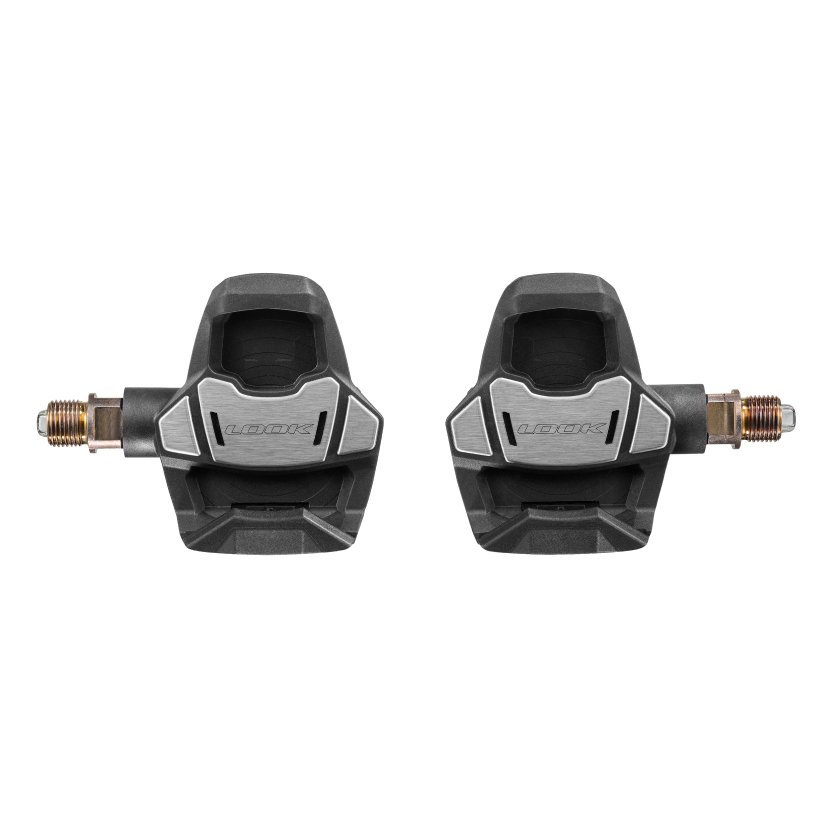
LOOK KEO Blade Power (Single-sided) scoring:
Accuracy 5/5 | Reliability 5/5 | Ease of Installation 5/5 | Battery Life 2/5 | Price 3/5 | WEIGHTED OVERALL SCORE 4.4/5
LOOK KEO Blade Power (Dual-sided) scoring:
Accuracy 5/5 | Reliability 5/5 | Ease of Installation 5/5 | Battery Life 2/5 | Price 2/5 | WEIGHTED OVERALL SCORE 4.3/5
Main Features
- Lightest power meter pedals
- Low stack (10.8mm)
- Advanced features (L/R balance, pedal smoothness, etc.)
- Available in single-sided or dual-sided options
- Auto zero-offset
- 2-year warranty
Technical Specification
- Accuracy: ±1%
- Weight: 260g (set)
- Cleat system: LOOK KEO
- Claimed battery life: 60h
- Battery type: Rechargeable
- Q Factor: 53 mm
- Stack height: 10.8 mm
LOOK KEO Blade Power pedal power meters and LOOK X-Track Power were introduced in early 2024. The latter is the MTB variant.
You can expect the same as from the Favero Assioma UNO/DUO, plus 10 hours longer battery life, 1mm shorter q-factor, and about 40g less weight.
The KEO Blade Power’s stack height is 10.8mm, which is 0.3mm higher than Assioma’s. You probably won’t notice this difference even if you are aggressive when cornering.
Until the introduction of the Favero Assioma RS-series, these were the lightest pedal power meters on the market. However, unless you are a LOOK fanboy (or fangirl), they don’t make much sense as the Assioma RS is more affordable, but offers virtually the same.
Also available at amazon.com
Also available at amazon.com
| Pedal Power Meters | For | Cleats | Accuracy | L/R Measurement | Weight (set) | Buy | Accuracy | Reliability | Ease of Installation | Battery Life | Price | Weighted Score |
|---|---|---|---|---|---|---|---|---|---|---|---|---|
| Favero Assioma RS-1 | Road | Shimano SPD-SL | ±1% | Single-sided | 249g | Check Price | 5 | 5 | 5 | 2 | 3 | 4.5 |
| Favero Assioma RS-2 | Road | Shimano SPD-SL | ±1% | Dual-sided | 250g | Check Price | 5 | 5 | 5 | 2 | 2 | 4.3 |
| Favero Assioma UNO | Road | LOOK KEO | ±1% | Single-sided | 299g | Check Price | 5 | 5 | 5 | 2 | 4 | 4.5 |
| Favero Assioma DUO | Road | LOOK KEO | ±1% | Dual-sided | 299g | Check Price | 5 | 5 | 5 | 2 | 3 | 4.4 |
| Favero Assioma DUO-Shi | Road | Shimano SPD-SL | ±1% | Dual-sided | 198g (w/o pedal body) | Check Price | 5 | 5 | 5 | 2 | 3 | 4.4 |
| Favero Assioma Pro MX1 | MTB/Gravel | Shimano SPD | ±1% | Single-sided | 383g | Check Price | 5 | 5 | 5 | 2 | 4 | 4.5 |
| Favero Assioma Pro MX2 | MTB/Gravel | Shimano SPD | ±1% | Dual-sided | 383g | Check Price | 5 | 5 | 5 | 2 | 3 | 4.4 |
| Garmin Rally XC110 | MTB/Gravel | Shimano SPD | ±1% | Single-sided | 444g | Check Price | 5 | 5 | 5 | 2 | 2 | 4.3 |
| Garmin Rally XC210 | MTB/Gravel | Shimano SPD | ±1% | Dual-sided | 436g | Check Price | 5 | 5 | 5 | 2 | 1 | 4.2 |
| Garmin Rally RS110 | Road | Shimano SPD-SL | ±1% | Single-sided | 328g | Check Price | 5 | 5 | 5 | 2 | 2 | 4.3 |
| Garmin Rally RS210 | Road | Shimano SPD-SL | ±1% | Dual-sided | 320g | Check Price | 5 | 5 | 5 | 2 | 1 | 4.2 |
| Garmin Rally RK110 | Road | LOOK KEO | ±1% | Single-sided | 334g | Check Price | 5 | 5 | 5 | 2 | 2 | 4.3 |
| Garmin Rally RK210 | Road | LOOK KEO | ±1% | Dual-sided | 326g | Check Price | 5 | 5 | 5 | 2 | 1 | 4.2 |
| Wahoo POWRLINK ZERO Single | Road | Wahoo Speedplay | ±1% | Single-sided | 276g | Check Price | 5 | 5 | 5 | 2 | 3 | 4.4 |
| Wahoo POWRLINK ZERO Dual | Road | Wahoo Speedplay | ±1% | Dual-sided | 276g | Check Price | 5 | 5 | 5 | 2 | 3 | 4.4 |
| LOOK KEO Blade Power Single | Road | LOOK KEO | ±1% | Dual-sided | 260g | Check Price Check Price (amazon.com) | 5 | 5 | 5 | 2 | 3 | 4.4 |
| LOOK KEO Blade Power Single | Road | LOOK KEO | ±1% | Dual-sided | 260g | Check Price Check Price (amazon.com) | 5 | 5 | 5 | 2 | 2 | 4.3 |
Honorable Mentions
LOOK X-Track Power were introduced in early 2024. They are similarly priced to Garmin Rally XC, but not as proven yet.
SRM X-Power pedals don’t provide a price-value ratio as good as Garmin Rally. The same applies to SRM LOOK Exact pedals, which are not competitive against Favero Assioma.
IQ2 Power Meter pedals seemed promising and were successfully backed on Kickstarter, but unfortunately, they didn’t make it into production.
Summary
When choosing a pedal power meter, consider whether you need a dual-sided power meter. It can cost twice as much as a single-sided one, and you may end up with data you won’t use.
The Favero Assioma RS are the best power meter pedals for road cycling. They are affordable, accurate, and reliable. These are the three main features to expect from a quality power meter. And, as a bonus, they are the lightest pedal power meters compatible with the SPD-SL cleat system.
The Favero Assioma PRO MX-1 (single-sided) and MX-2 (dual-sided) are the best pedal power meters for MTB and gravel. These SPD-style pedals are durable enough to withstand the elements and harsh MTB conditions. They will also provide accurate and consistent data and are more affordable than the competition.
Read the How to Choose Power Meter Pedals section to learn more about the features, benefits, and disadvantages of pedal power meters.
How to Choose Power Meter Pedals?
This guide focuses solely on choosing pedal power meters. The following table compares different power meter types.
| Power Meter Type | Pros | Cons |
|---|---|---|
| Pedal | • Easily transferable between bikes • Compatible with almost any bike (assuming you use it with a particular bike type) • Easy to set up • Very accurate • Can measure both legs independently | • Prone to mechanical damage (clipping in, crashes, etc.) • High added (rotating) weight (assuming you have lighter pedals) |
| Crank Arm | • Low added (rotating) weight • Very accurate • More affordable | • Not easily transferable between bikes (unless both bikes use the same cranks) • Limited components compatibility • Can’t measure both legs independently (unless you use dual-sided crank arm power meters) |
| Spider | • Low added (rotating) weight • Very accurate • Reliable | • Limited components compatibility • Less affordable • Not easy to set up |
| Bottom Bracket | • Low added (rotating) weight • Very accurate • Reliable • Protected against mechanical damage | • Limited components compatibility • Complicated installation • Not easily transferable between bikes |
| Handlebar | • No added (rotating) weight • Easily transferable between bikes • Compatible with virtually any bike | • Less accurate • Require attaching other sensors (speed + cadence) to your bike • Prone to damage when crashing • Can’t detect cadence |
| Hub | • No added (rotating) weight • Easily transferable between bikes (assuming the bikes use the same wheels) | • Require replacing your current hubs or buying a whole wheelset • Can be heavier than your current hubs |
Sources: powermetercity.com, GC Performance, discussions with pro cyclists
NOTE: To learn more about other types of pedals, visit my power meter guide.
Now, let’s dive deeper into the features to look for when choosing pedal power meters.
Data Accuracy and Consistency
Pedal power meters are among the most accurate because they measure power closer to its source. The accuracy rate of pedal power meters is usually ±1%. Other power meter types vary between ±1% and ±3%.
Unless you are hyper-sensitive to data accuracy, you won’t notice the slight differences between pedal power meters in lower power zones. Check out the following table for the power deviations of different accuracy rates.
| Accuracy Rate / Power Output | 250W | 500W | 1000W |
|---|---|---|---|
| 0.5% | 248.8-251.3 | 497.5-502.5 | 502.5-1005 |
| 1% | 247.5-252.5 | 495-505 | 990-1010 |
| 1.5% | 246.3-253.8 | 492.5-507.5 | 985-1015 |
| 2% | 245-255 | 490-510 | 980-1020 |
| 2.5% | 243.8-256.3 | 487.5-512.5 | 975-1025 |
| 3% | 242.5-257.5 | 485-515 | 970-1030 |
Data consistency is more important. Consistency means that a power meter measures consistent data regardless of the used bike, outside temperature, altitude, etc.
Consistent data are the key to effective training. You don’t want a power meter with high volatility (once it measures 190W, then 210W while you ride at 200W, for example).
You can learn more about this topic in my article power meter accuracy vs. power meter consistency.
Cleats Compatibility
Today’s power meter pedals are primarily compatible with LOOK and Shimano cleats.
Road bike power meter pedals like Favero Assioma DUO and UNO are designed for LOOK KEO cleats. If you want a Shimano SPD-SL-compatible Favero Assioma power meter, you must buy DUO-Shi Spindles.
Garmin’s Rally line offers more options. The ‘RS‘ pedals are compatible with Shimano SPD-SL cleats, while the ‘RK‘ are with LOOK KEO cleats. The mountain bike Rally ‘XC‘ pedals are compatible with the standard Shimano SPD system we know from clipless mountain bike pedals.
The only power meter pedals compatible with the Wahoo Speedplay system are the POWRLINK ZERO power meter pedals, launched in early 2022.
Left/Right Leg Measurement
Pedal power meters can be:
- Single-sided – they measure the left leg only and estimate your overall power output.
- Dual-sided – measure the power output of both your legs independently.
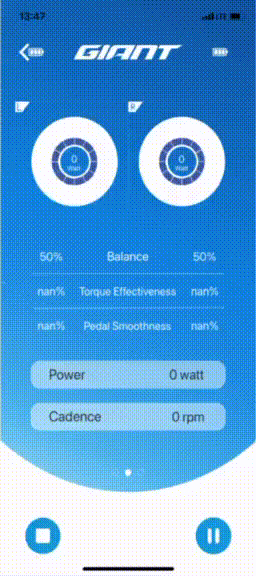
Single-sided power meters have one significant disadvantage. They are not suitable for single-leg drills because they show zero power for the leg where the power sensor isn’t located (usually your right leg).
Read my summary of single vs. dual-sided power meters, where you learn which one you should choose.
Getting dual-sided pedal power meters may seem tempting, but you must remember that dual-sided power meters are more expensive. Furthermore, analyzing the additional data is not as easy as it may seem.
The left/right leg balance is also an interesting topic. You are fine if you find out your balance is 52:48 and you don’t experience any pain.
However, some riders may have the same imbalance and experience left knee pain. If you are one of them, consult a physiotherapist or a bike fitter.
I also recommend watching the following video from TrainerRoad’s YouTube channel and reading this article on TrainingPeaks.com to learn more about L/R imbalance.
Q Factor, Spindle, and Stance Width
When buying power meter pedals, you encounter the so-called Q factor. It’s often mixed up with a spindle width and stance width. They are defined as follows:
The Q factor is the width between the inside faces of the cranks where the pedals screw in.
The spindle width (also called spindle length) is the distance from the outside of the cranks to the pedal center.
The last important term is the stance width. It is the width between the centers of the pedals.

Pedal power meter manufacturers use the Q factor to describe the spindle width.
Pedals with a wider spindle width than your current will cause your legs to be further apart and may also affect your cornering ability.
Luckily, most pedal power meters have a spindle width close to standard pedals (around 53mm).
Zero-Offset vs. Calibration
Zero-offset ≠ Calibration
These two terms are often mixed up. So, what is the difference? Josh Matthew from Power Meter City explained them as follows:
Calibration is a one-time process done during manufacturing, while zero-offsetting should be done by the rider before every ride.
Pedal power meters can have:
- Manual zero-offset – done manually by the rider via a power meter app or a head unit.
- Automatic zero-offset – done automatically before every ride.
Naturally, pedal power meters with an automatic zero-offset are more convenient and user-friendly.
To learn why this is important, read my article explaining calibration vs. zero-offset.
Battery Type and Battery Life
Pedal power meters use one of the following two battery types:
- Single-use batteries (LR44/SR44, CR1/3N, etc.) – tend to last longer*, but require replacing.
- In-built, rechargeable batteries don’t last as long as single-use batteries, but you can recharge them.
*Power Meter City found out that rechargeable batteries lasted only 140 hours, while single-use batteries 230 hours on average.
For example, Favero Assioma pedals use a rechargeable battery and have a claimed battery life of 50 hours. The Garmin Rally pedals use single-use batteries and have a claimed battery life of up to 120 hours.
Weight
Pedal power meters tend to be slightly heavier than standard road bike pedals. Here are a few examples:
- Shimano 105 road bike pedals: 276g
- Shimano Ultegra road bike pedals: 248g
- LOOK Keo 2 Max Carbon: 250g
- Time Xpro 10 road bike pedals: 226g
Depending on the pedals you currently use, the added rotating weight may be one of the most significant downsides of pedal power meters.
Brand
There are just a few brands that specialize in pedal power meters.
- Favero and their Assioma line belong to the most popular ones thanks to their affordable price, high reliability, and precision.
- Garmin launched their first power meter pedal line called Vector. Unfortunately, owners of these pedals often experience battery issues. Luckily for Garmin, they saved their reputation with the launch of the Rally line in 2021.
- SRM is one of the most experienced power meter companies. They teamed up with LOOK and introduced EXAKT power meters. They look sleek and have long battery life, but they have a complicated setup process and are expensive.


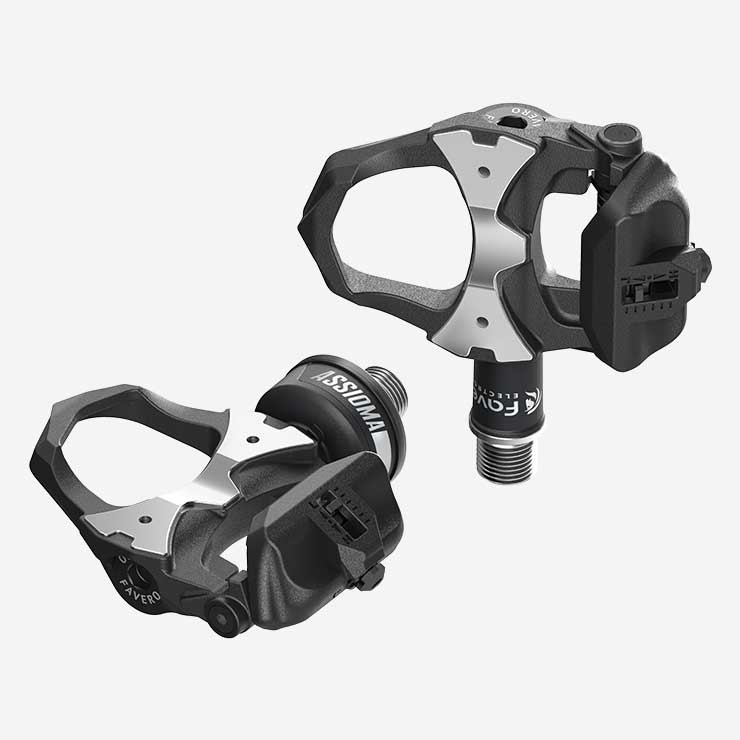



Your comparison helped me to decide, Favero Assioma Duo looks like the best option.
That’s because it is! Haha.
– Petr
Used to own Favero Assioma Duo-Shi. The left broke after 18 months. Their customer service is really bad. Never Favero again for me.
Hi Patrick,
Thanks for sharing your experience. They didn’t reply to your warranty claim email or what happened?
– Petr
I have mountain bike power meters and have moved them between my road and gravel bike. Should I get a road bike power meter? Will I feel more comfortable on road bike pedals?
thanks
Hi Tal,
Road bike pedals provide better foot support. I recommend borrowing road bike pedals and trying how they feel. I believe you will feel better on road pedals. You can check out my article on How to choose bike pedals. 🙂
– Petr
Thanks
The current SRM pedals available in SPD MTB, road and flat are easy to set up.